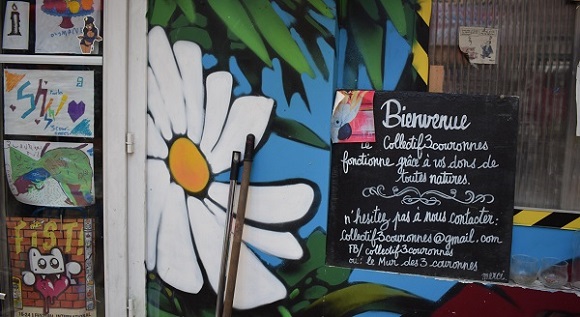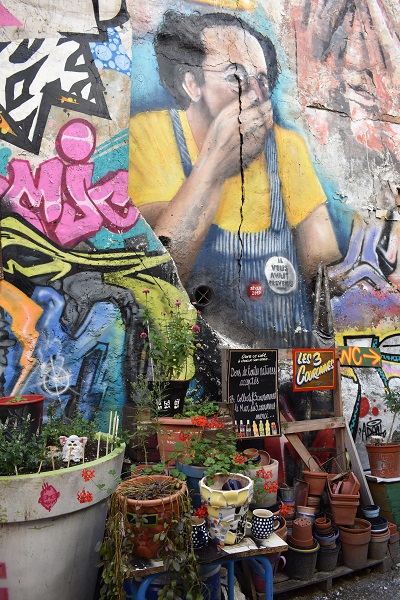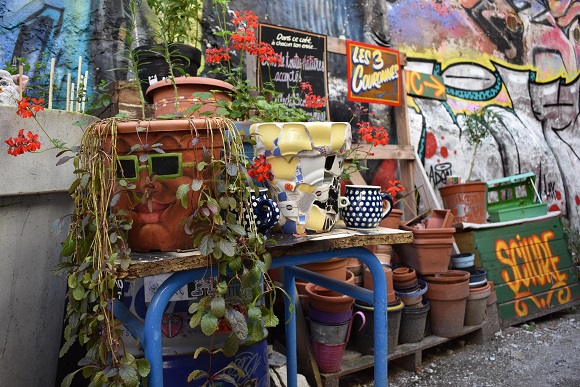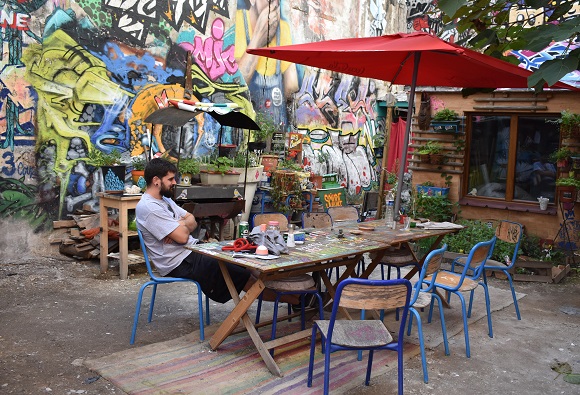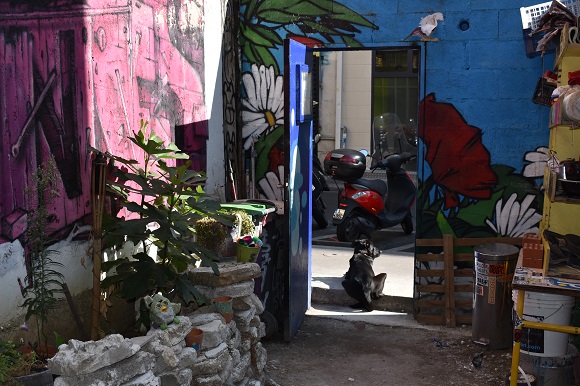
Having survived an encounter with chadors, communists and cannibals in part 1 of this two-part vignette, two American visitors in eastern Paris encounter a graffer, a gardener, a homeless shelter and cheerful graffiti beyond the Wall of 3 Crowns. But first they have to get past the dog.
Part 2, The Wall of 3 Crowns
Two road diverged after the Yellow Tree café and they, standing by the Amen travel agency, they took the one less traveled by buses, thinking wrongly that it was the continuation of rue Jean-Pierre Timbaud. No matter, it was just as fair, and they soon spotted a colorful wall down the block there.
Birds and words had been spray painted on the wall against a bright blue background. Along the wall was an open door.
If an open door is an invitation, she said, what’s an open door with a Doberman lying across the threshold, a guarded invitation?
A sign that the door is being repaired?
The dog’s coat was as black and shiny as a burka the beach. It gave them a lazy look and incuriously set down its chin.
That’s not a Doberman, he said. That’s a mutt hoping to find some pinscher or weimaraner in his 23andMe report.
They looked beyond the open door. Within was a cheerfully graffitied space between two buildings, with dozens of potted plants and a cabin of sorts in the back. It was altogether about twice the size of the Airbnb they were renting in the Marais. Two men sat at opposite ends of a long wooden table, one reading a newspaper, the other leaning over the table. They appeared to be waiting for Godot. For a moment neither looked over.
Bonjour, the man and the woman said from the threshold.
At one end of the table, a bearded fellow of about 30 looked up to them, muttered bonjour, then immediately turned back to what he was doing: drawing with a blue marker on the table. The other, probably in his 50s, got up, picked up a piece of paper from the table and brought it over to them.
You can come in, he said. Visit. Take pictures. Sit down. Whatever.
He sat back down at the opposite end of the table from the man who was coloring the table with a marker. He picked up the newspaper and began reading.
The man and the woman looked at each other and entered.
It disturbed him that the fellow had mentioned that they could take pictures, as though he saw them not as strollers idling by on a Sunday afternoon but as sightseers seeking photo-ops. Then he realized that his Nikon was hanging from his neck.
He read aloud, in French, a heading on the little brochure he’d been given: The 3 crowns collective, what is it?
The older man had apparently been waiting for the question. He turned to them and explained: This was an urban wasteland where people used to throw trash and was occasionally squatted by homeless people and tagged. Now it’s a project run by the Collectif 3 Couronnes, all volunteers, to lodge one or two homeless people at a time until suitable permanent housing can be found, while welcoming all comers to rest, gather and socialize and some to make graffiti. He’s one of the graffers, he said of the fellow with the blue marker at the other end of the table.
The graffer didn’t look up. Both the man and the woman thought he might socially stunted.
Which of these graffiti did you do? asked the man.
The graffer, pointing with his marker, said he’d done Coluche here
and Guardians of the Galaxy there.
How do you choose your subjects?
It’s for the fun of it, he said. You can’t take yourself too seriously. Keep it colorful.
The Guardians were obviously superheroes—he recognized Rocket Raccoon. But who was Coluche? He looked up Coluche on his phone as the men returned to what they’d been doing: drawing on the table and reading a newspaper. Coluche, he found, was a popular comedian and the founder, in 1985, shortly before his death in a motorcycle accident at the age of 41, of Les Restos du Coeur, a non-profit organization whose mission is to help and assist the poor and the destitute, particularly by providing free meals and participating in their social and economic insertion.
How long do they stay? she finally said. The homeless.
It depends on how long it takes to find more permanent lodging, said the older man, and if they’re willing to stay.
We couldn’t get some to stay here at first, said the graffer. They didn’t like the place.
There’s no electricity, said the other, and that’s a dry toilet over there behind the curtain.
But it’s shelter? said the man with the camera. And they need shelter.
You might think so, said the graffer. But if the goal is to get real lodging of the kind we all deserve—and that’s the goal—then this is unacceptable to some. And some didn’t like all that was going on in the neighborhood, you know, out in the street, up there.
It’s calmed down though, said the other.
She realized that the graffer, far from socially stunted, had been sizing them up before speaking.
Where else do you do graffiti? she asked.
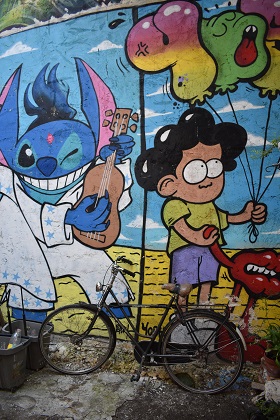 That led to a conversation between the two of them about the evolution of graffiti-friendly neghborhoods in Berlin, Budapest, Tokyo, Boston and elsewhere. As they spoke, the man with the camera took pictures. Listening to the conversation he was as surprised by the graffer’s knowledge of the world as he was by her apparent knowledge of the places he spoke about. She’d never mentioned knowing anything about street art or that she’d ever been to Budapest.
That led to a conversation between the two of them about the evolution of graffiti-friendly neghborhoods in Berlin, Budapest, Tokyo, Boston and elsewhere. As they spoke, the man with the camera took pictures. Listening to the conversation he was as surprised by the graffer’s knowledge of the world as he was by her apparent knowledge of the places he spoke about. She’d never mentioned knowing anything about street art or that she’d ever been to Budapest.
The graffer spoke about art squats, squatters, travel and graffiti. She thought him too well traveled to have ever been homeless in a needy sense. He seemed to be more of a traveler, seeking out people, places, experiences—someone on a personal quest. She politely asked how he lived, meaning how he managed the economics of his life, and he mentioned his paid decorative work for clients.
What do you like about squats? she asked.
Studio space, he replied, and the people. We need to help people—help each other—on a local basis rather than look for mega solutions from politicians. Money doesn’t help in that case, it corrupts.
She, for her part, believed in mega solutions and in the importance of education, statistics and the fight against demagogues and fake news. Helping people individually, we should all do that. But only top down had significant results. Didn’t the French think that? Or had she misunderstood something.
Sometimes I think about leaving the city to live in a small town and help people there, he said.
There was a pause in the conversation. She got up and examined the potted plans while he continued to take pictures.
The older man had said little since she’d begun speaking with the graffer. It was as though they took turns entertaining the guests. The graffer then brought him back into the conversation by saying it was he, the older one, who cared for the plants.
We ask the person we’re housing to take care of the plants when I’m away, but if I come back after a two- or three-week absence they’re dead.
I hope you mean the plants, said the man with the camera, but the fellow didn’t seem to get the joke. Where do you go? he asked.
I leave, said the gardener.
I’d like to take a wide shot with the table in it, he announced. Do you mind if you’re in it?
I don’t want to be in any pictures, said the gardener, getting up from the chair.
How about you? he asked the graffer.
I don’t care, he said. I don’t believe in copyright.
They chatted with the men a bit more then nodded to each other that it was time to go. They shook hands and said good-bye. They stepped over the dog and out to the street.
Did I ever tell you how good your French is? he said to her.
Yeh, the first time you tried to get me into bed.
Well it is. I just want to say it again, sincerely this time.
He offered his hand and she took it.
I guess it’s true what they say about visiting Paris, she said.
What’s that?
That it even turns pigs into romantics.
Text and photos © 2018, Gary Kraut
Return to Part 1, Street Talk Paris: Chadors, Cannibals, Communists.



